Food and Beverage Operations Management: A Restaurant Analysis
VerifiedAdded on 2023/01/12
|6
|1283
|26
Report
AI Summary
This report analyzes food and beverage operations management, focusing on Lisa's restaurant. It explores various food production systems like cook-freeze, assembly kitchen, sous vide, and centralized production, highlighting their benefits and applications. Different F&B service approaches such as robotic, blue plate, take away, buffet, and Russian service are examined. The report also delves into volume forecasting and food production control, emphasizing standard portion sizes, yield, and recipes. It underscores the importance of HACCP for food safety and concludes that implementing these strategies can enhance customer base and sales. The analysis provides a comprehensive overview of key elements in effective food and beverage operations.
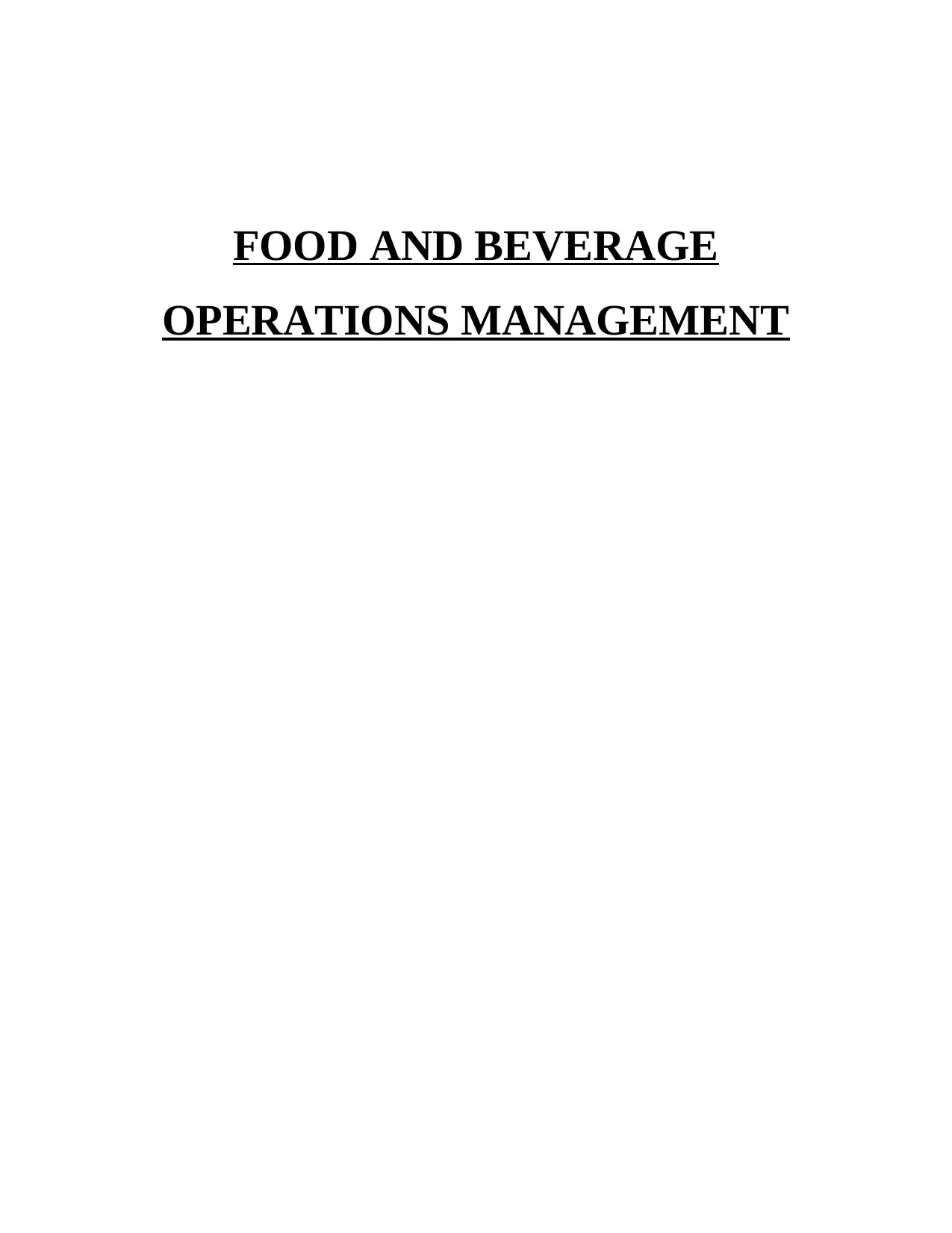
FOOD AND BEVERAGE
OPERATIONS MANAGEMENT
OPERATIONS MANAGEMENT
Paraphrase This Document
Need a fresh take? Get an instant paraphrase of this document with our AI Paraphraser
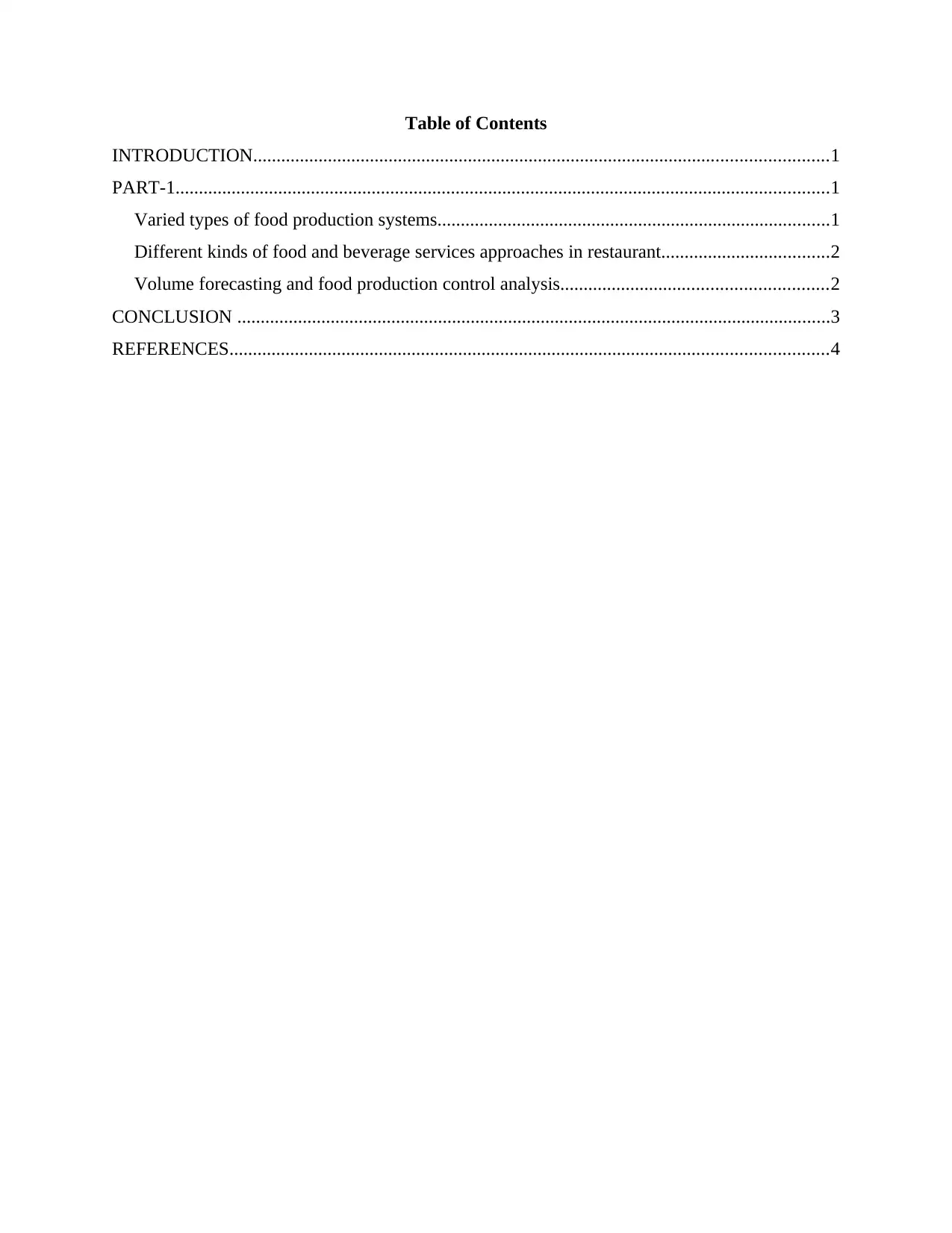
Table of Contents
INTRODUCTION...........................................................................................................................1
PART-1............................................................................................................................................1
Varied types of food production systems....................................................................................1
Different kinds of food and beverage services approaches in restaurant....................................2
Volume forecasting and food production control analysis.........................................................2
CONCLUSION ...............................................................................................................................3
REFERENCES................................................................................................................................4
INTRODUCTION...........................................................................................................................1
PART-1............................................................................................................................................1
Varied types of food production systems....................................................................................1
Different kinds of food and beverage services approaches in restaurant....................................2
Volume forecasting and food production control analysis.........................................................2
CONCLUSION ...............................................................................................................................3
REFERENCES................................................................................................................................4
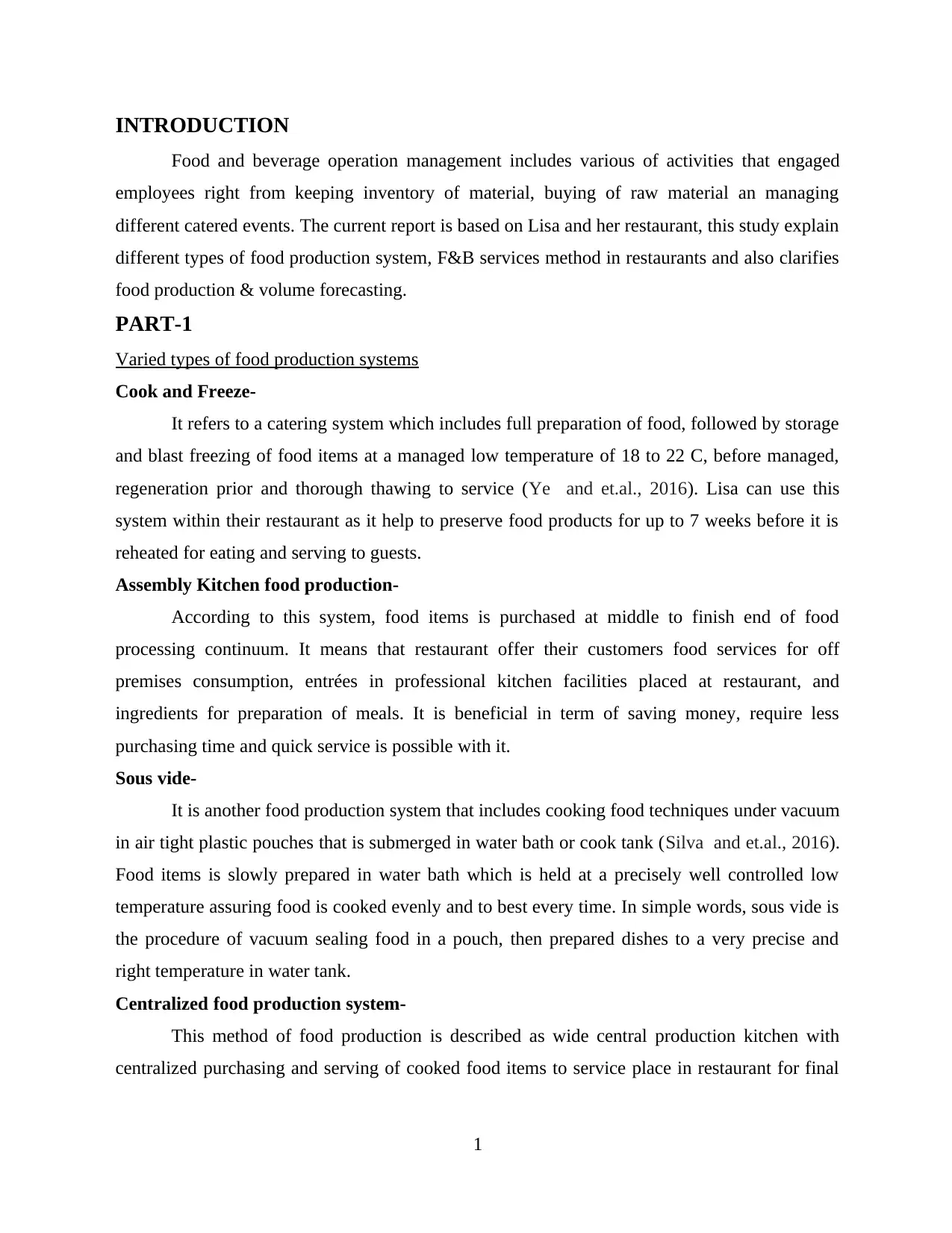
INTRODUCTION
Food and beverage operation management includes various of activities that engaged
employees right from keeping inventory of material, buying of raw material an managing
different catered events. The current report is based on Lisa and her restaurant, this study explain
different types of food production system, F&B services method in restaurants and also clarifies
food production & volume forecasting.
PART-1
Varied types of food production systems
Cook and Freeze-
It refers to a catering system which includes full preparation of food, followed by storage
and blast freezing of food items at a managed low temperature of 18 to 22 C, before managed,
regeneration prior and thorough thawing to service (Ye and et.al., 2016). Lisa can use this
system within their restaurant as it help to preserve food products for up to 7 weeks before it is
reheated for eating and serving to guests.
Assembly Kitchen food production-
According to this system, food items is purchased at middle to finish end of food
processing continuum. It means that restaurant offer their customers food services for off
premises consumption, entrées in professional kitchen facilities placed at restaurant, and
ingredients for preparation of meals. It is beneficial in term of saving money, require less
purchasing time and quick service is possible with it.
Sous vide-
It is another food production system that includes cooking food techniques under vacuum
in air tight plastic pouches that is submerged in water bath or cook tank (Silva and et.al., 2016).
Food items is slowly prepared in water bath which is held at a precisely well controlled low
temperature assuring food is cooked evenly and to best every time. In simple words, sous vide is
the procedure of vacuum sealing food in a pouch, then prepared dishes to a very precise and
right temperature in water tank.
Centralized food production system-
This method of food production is described as wide central production kitchen with
centralized purchasing and serving of cooked food items to service place in restaurant for final
1
Food and beverage operation management includes various of activities that engaged
employees right from keeping inventory of material, buying of raw material an managing
different catered events. The current report is based on Lisa and her restaurant, this study explain
different types of food production system, F&B services method in restaurants and also clarifies
food production & volume forecasting.
PART-1
Varied types of food production systems
Cook and Freeze-
It refers to a catering system which includes full preparation of food, followed by storage
and blast freezing of food items at a managed low temperature of 18 to 22 C, before managed,
regeneration prior and thorough thawing to service (Ye and et.al., 2016). Lisa can use this
system within their restaurant as it help to preserve food products for up to 7 weeks before it is
reheated for eating and serving to guests.
Assembly Kitchen food production-
According to this system, food items is purchased at middle to finish end of food
processing continuum. It means that restaurant offer their customers food services for off
premises consumption, entrées in professional kitchen facilities placed at restaurant, and
ingredients for preparation of meals. It is beneficial in term of saving money, require less
purchasing time and quick service is possible with it.
Sous vide-
It is another food production system that includes cooking food techniques under vacuum
in air tight plastic pouches that is submerged in water bath or cook tank (Silva and et.al., 2016).
Food items is slowly prepared in water bath which is held at a precisely well controlled low
temperature assuring food is cooked evenly and to best every time. In simple words, sous vide is
the procedure of vacuum sealing food in a pouch, then prepared dishes to a very precise and
right temperature in water tank.
Centralized food production system-
This method of food production is described as wide central production kitchen with
centralized purchasing and serving of cooked food items to service place in restaurant for final
1
⊘ This is a preview!⊘
Do you want full access?
Subscribe today to unlock all pages.

Trusted by 1+ million students worldwide
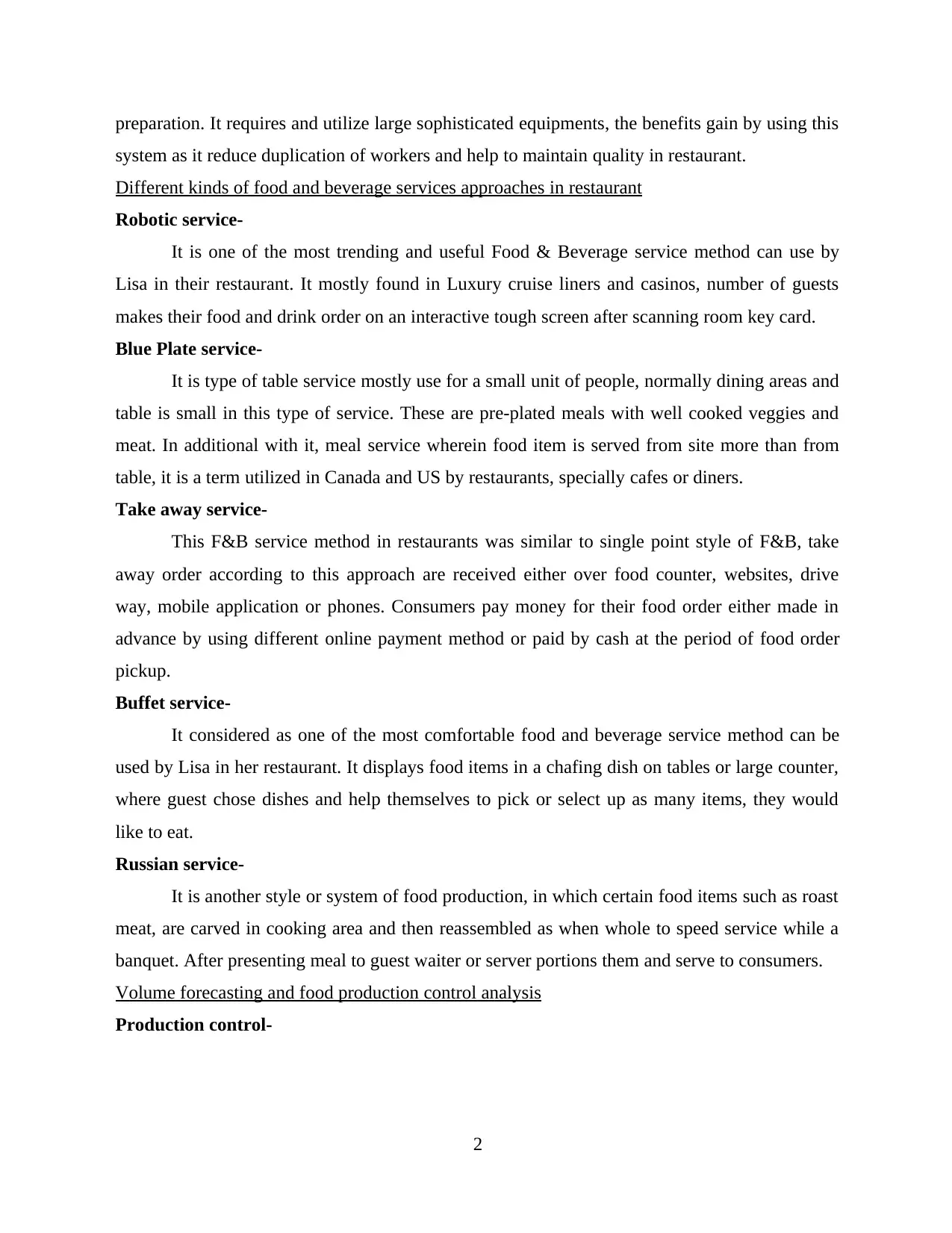
preparation. It requires and utilize large sophisticated equipments, the benefits gain by using this
system as it reduce duplication of workers and help to maintain quality in restaurant.
Different kinds of food and beverage services approaches in restaurant
Robotic service-
It is one of the most trending and useful Food & Beverage service method can use by
Lisa in their restaurant. It mostly found in Luxury cruise liners and casinos, number of guests
makes their food and drink order on an interactive tough screen after scanning room key card.
Blue Plate service-
It is type of table service mostly use for a small unit of people, normally dining areas and
table is small in this type of service. These are pre-plated meals with well cooked veggies and
meat. In additional with it, meal service wherein food item is served from site more than from
table, it is a term utilized in Canada and US by restaurants, specially cafes or diners.
Take away service-
This F&B service method in restaurants was similar to single point style of F&B, take
away order according to this approach are received either over food counter, websites, drive
way, mobile application or phones. Consumers pay money for their food order either made in
advance by using different online payment method or paid by cash at the period of food order
pickup.
Buffet service-
It considered as one of the most comfortable food and beverage service method can be
used by Lisa in her restaurant. It displays food items in a chafing dish on tables or large counter,
where guest chose dishes and help themselves to pick or select up as many items, they would
like to eat.
Russian service-
It is another style or system of food production, in which certain food items such as roast
meat, are carved in cooking area and then reassembled as when whole to speed service while a
banquet. After presenting meal to guest waiter or server portions them and serve to consumers.
Volume forecasting and food production control analysis
Production control-
2
system as it reduce duplication of workers and help to maintain quality in restaurant.
Different kinds of food and beverage services approaches in restaurant
Robotic service-
It is one of the most trending and useful Food & Beverage service method can use by
Lisa in their restaurant. It mostly found in Luxury cruise liners and casinos, number of guests
makes their food and drink order on an interactive tough screen after scanning room key card.
Blue Plate service-
It is type of table service mostly use for a small unit of people, normally dining areas and
table is small in this type of service. These are pre-plated meals with well cooked veggies and
meat. In additional with it, meal service wherein food item is served from site more than from
table, it is a term utilized in Canada and US by restaurants, specially cafes or diners.
Take away service-
This F&B service method in restaurants was similar to single point style of F&B, take
away order according to this approach are received either over food counter, websites, drive
way, mobile application or phones. Consumers pay money for their food order either made in
advance by using different online payment method or paid by cash at the period of food order
pickup.
Buffet service-
It considered as one of the most comfortable food and beverage service method can be
used by Lisa in her restaurant. It displays food items in a chafing dish on tables or large counter,
where guest chose dishes and help themselves to pick or select up as many items, they would
like to eat.
Russian service-
It is another style or system of food production, in which certain food items such as roast
meat, are carved in cooking area and then reassembled as when whole to speed service while a
banquet. After presenting meal to guest waiter or server portions them and serve to consumers.
Volume forecasting and food production control analysis
Production control-
2
Paraphrase This Document
Need a fresh take? Get an instant paraphrase of this document with our AI Paraphraser
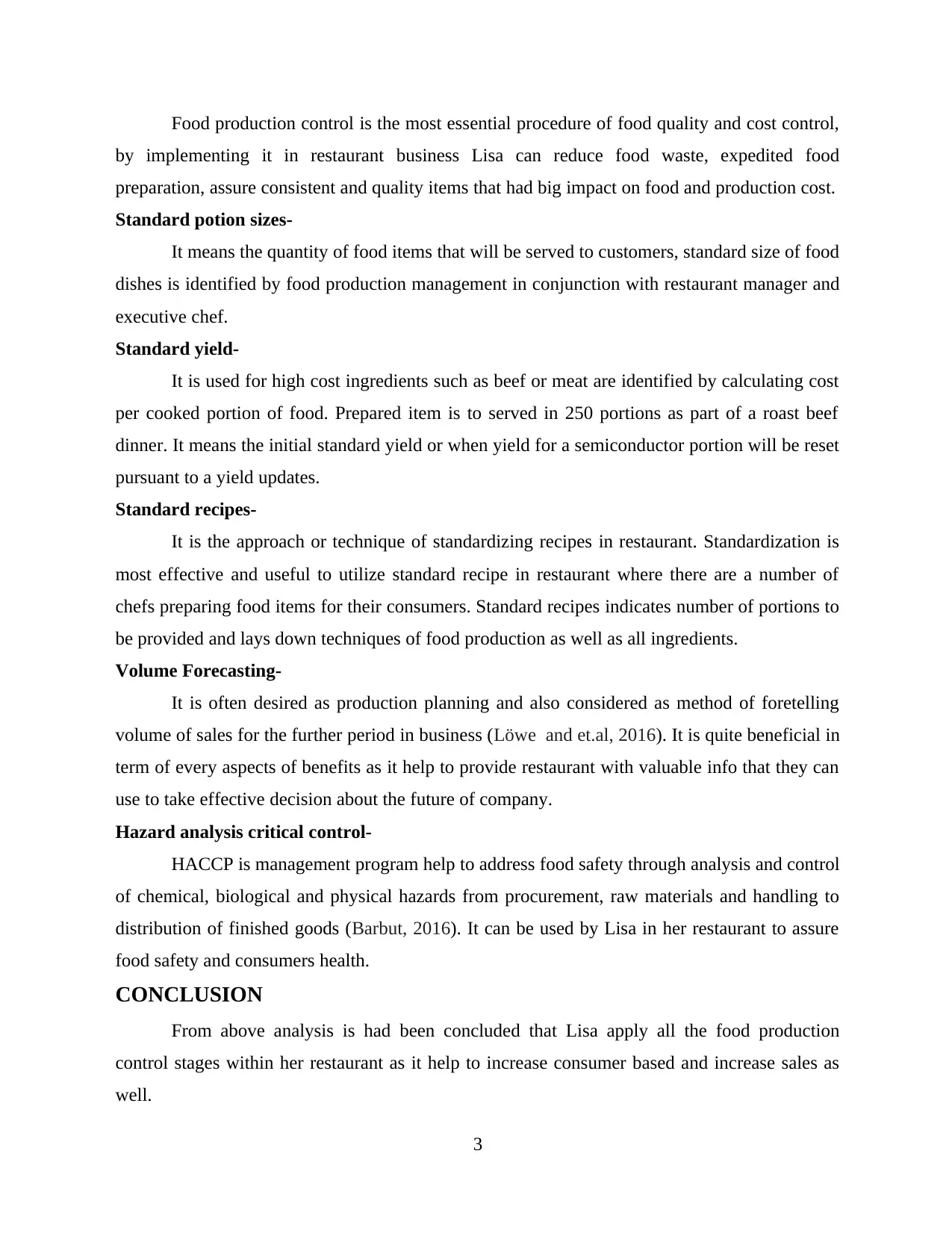
Food production control is the most essential procedure of food quality and cost control,
by implementing it in restaurant business Lisa can reduce food waste, expedited food
preparation, assure consistent and quality items that had big impact on food and production cost.
Standard potion sizes-
It means the quantity of food items that will be served to customers, standard size of food
dishes is identified by food production management in conjunction with restaurant manager and
executive chef.
Standard yield-
It is used for high cost ingredients such as beef or meat are identified by calculating cost
per cooked portion of food. Prepared item is to served in 250 portions as part of a roast beef
dinner. It means the initial standard yield or when yield for a semiconductor portion will be reset
pursuant to a yield updates.
Standard recipes-
It is the approach or technique of standardizing recipes in restaurant. Standardization is
most effective and useful to utilize standard recipe in restaurant where there are a number of
chefs preparing food items for their consumers. Standard recipes indicates number of portions to
be provided and lays down techniques of food production as well as all ingredients.
Volume Forecasting-
It is often desired as production planning and also considered as method of foretelling
volume of sales for the further period in business (Löwe and et.al, 2016). It is quite beneficial in
term of every aspects of benefits as it help to provide restaurant with valuable info that they can
use to take effective decision about the future of company.
Hazard analysis critical control-
HACCP is management program help to address food safety through analysis and control
of chemical, biological and physical hazards from procurement, raw materials and handling to
distribution of finished goods (Barbut, 2016). It can be used by Lisa in her restaurant to assure
food safety and consumers health.
CONCLUSION
From above analysis is had been concluded that Lisa apply all the food production
control stages within her restaurant as it help to increase consumer based and increase sales as
well.
3
by implementing it in restaurant business Lisa can reduce food waste, expedited food
preparation, assure consistent and quality items that had big impact on food and production cost.
Standard potion sizes-
It means the quantity of food items that will be served to customers, standard size of food
dishes is identified by food production management in conjunction with restaurant manager and
executive chef.
Standard yield-
It is used for high cost ingredients such as beef or meat are identified by calculating cost
per cooked portion of food. Prepared item is to served in 250 portions as part of a roast beef
dinner. It means the initial standard yield or when yield for a semiconductor portion will be reset
pursuant to a yield updates.
Standard recipes-
It is the approach or technique of standardizing recipes in restaurant. Standardization is
most effective and useful to utilize standard recipe in restaurant where there are a number of
chefs preparing food items for their consumers. Standard recipes indicates number of portions to
be provided and lays down techniques of food production as well as all ingredients.
Volume Forecasting-
It is often desired as production planning and also considered as method of foretelling
volume of sales for the further period in business (Löwe and et.al, 2016). It is quite beneficial in
term of every aspects of benefits as it help to provide restaurant with valuable info that they can
use to take effective decision about the future of company.
Hazard analysis critical control-
HACCP is management program help to address food safety through analysis and control
of chemical, biological and physical hazards from procurement, raw materials and handling to
distribution of finished goods (Barbut, 2016). It can be used by Lisa in her restaurant to assure
food safety and consumers health.
CONCLUSION
From above analysis is had been concluded that Lisa apply all the food production
control stages within her restaurant as it help to increase consumer based and increase sales as
well.
3
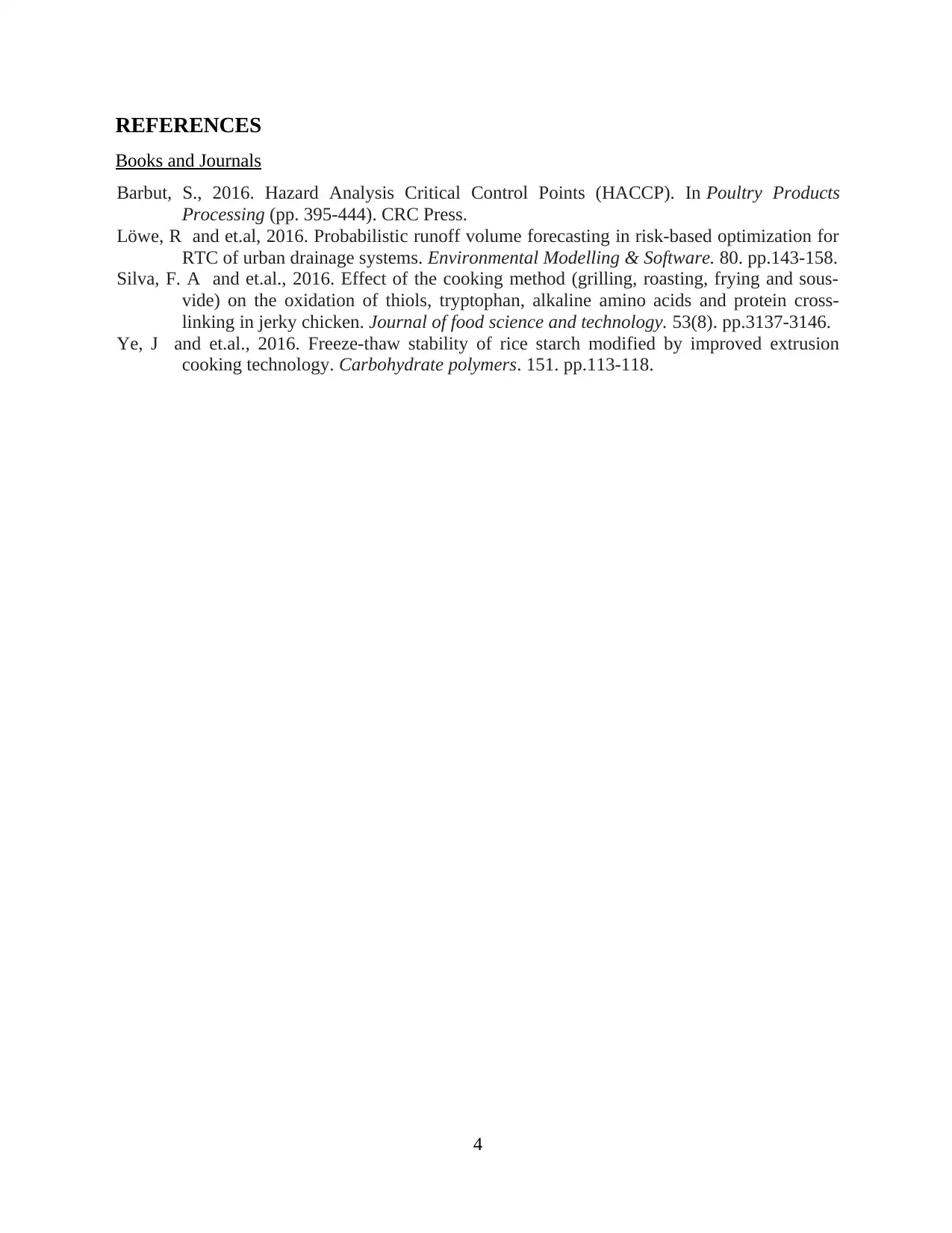
REFERENCES
Books and Journals
Barbut, S., 2016. Hazard Analysis Critical Control Points (HACCP). In Poultry Products
Processing (pp. 395-444). CRC Press.
Löwe, R and et.al, 2016. Probabilistic runoff volume forecasting in risk-based optimization for
RTC of urban drainage systems. Environmental Modelling & Software. 80. pp.143-158.
Silva, F. A and et.al., 2016. Effect of the cooking method (grilling, roasting, frying and sous-
vide) on the oxidation of thiols, tryptophan, alkaline amino acids and protein cross-
linking in jerky chicken. Journal of food science and technology. 53(8). pp.3137-3146.
Ye, J and et.al., 2016. Freeze-thaw stability of rice starch modified by improved extrusion
cooking technology. Carbohydrate polymers. 151. pp.113-118.
4
Books and Journals
Barbut, S., 2016. Hazard Analysis Critical Control Points (HACCP). In Poultry Products
Processing (pp. 395-444). CRC Press.
Löwe, R and et.al, 2016. Probabilistic runoff volume forecasting in risk-based optimization for
RTC of urban drainage systems. Environmental Modelling & Software. 80. pp.143-158.
Silva, F. A and et.al., 2016. Effect of the cooking method (grilling, roasting, frying and sous-
vide) on the oxidation of thiols, tryptophan, alkaline amino acids and protein cross-
linking in jerky chicken. Journal of food science and technology. 53(8). pp.3137-3146.
Ye, J and et.al., 2016. Freeze-thaw stability of rice starch modified by improved extrusion
cooking technology. Carbohydrate polymers. 151. pp.113-118.
4
⊘ This is a preview!⊘
Do you want full access?
Subscribe today to unlock all pages.

Trusted by 1+ million students worldwide
1 out of 6
Related Documents
Your All-in-One AI-Powered Toolkit for Academic Success.
+13062052269
info@desklib.com
Available 24*7 on WhatsApp / Email
![[object Object]](/_next/static/media/star-bottom.7253800d.svg)
Unlock your academic potential
Copyright © 2020–2025 A2Z Services. All Rights Reserved. Developed and managed by ZUCOL.





